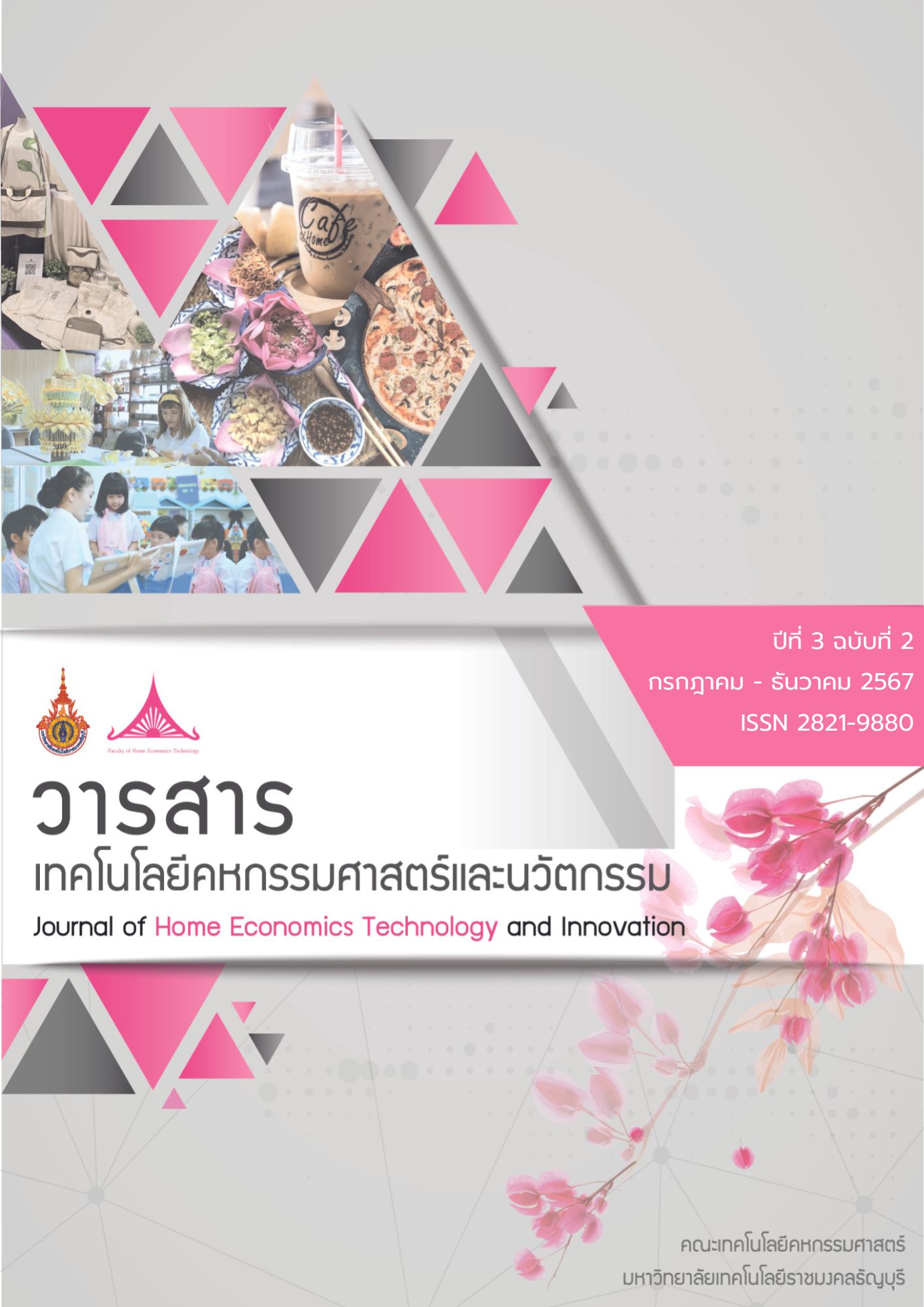Value Enhancement of Second-Hand Clothing through Deconstruction Concept
Main Article Content
Abstract
This research aimed to develop design approaches for second-hand clothing using the Deconstruction concept to enhance value and sustainability in the fashion industry.
The findings on value enhancement of second-hand clothing through Deconstruction revealed that this concept, when applied to fashion design, involves dismantling garment structures and reconstructing them with new design perspectives. This process enables the creation of new wearable pieces through various techniques, representing a unique art form that reflects the artist's identity through fabric manipulation, ultimately transforming into valuable wearable art. Analysis of five fashion brands implementing Deconstruction concepts - COMME des GARÇONS, Yohji Yamamoto, Andreas Kronthaler for Vivienne Westwood, Dry Clean Only, and La Rocca - revealed shared production approaches incorporating deconstruction, patchwork, and upcycling concepts. The researcher synthesized these concepts through a moodboard and created a collection of six outfits using second-hand denim. These designs were evaluated by five textile and clothing experts, comprising three tailoring specialists and two design experts. All six outfits received positive evaluations, confirming their production viability. The garment production process consisted of seven steps: 1) pattern drafting, 2) second-hand denim selection, 3) cleaning and drying, 4) cutting and pattern placement, 5) sewing, 6) model fitting, and 7) photography.
Article Details
Articles published are copyright of the Journal of Home Economics Technology and Innovation. Rajamangala University of Technology Thanyaburi The statements contained in each article in this academic journal are the personal opinions of each author and are not related to Rajamangala University of Technology Thanyaburi and other faculty members at the university in any way Responsibility for all elements of each article belongs to each author. If there is any mistake Each author is solely responsible for his or her own articles.
References
จิดาภา บุญเมือง. (2566, 29 สิงหาคม). Fashion 101: Deconstruction เมื่อการ “รื้อถอน” กลายเป็นศิลปะในโลกแห่งแฟชั่น.
Fashion 101: Deconstruction...เมื่อการ “รื้อถอน” กลายเป็นศิลปะในโลกแห่งแฟชั่น! - L'Officiel Thailand (lofficielthailand.com)
จี๊ด เมืองสิริขวัญ. (2564, 14 มีนาคม). COMME des GARÇONS. เมื่อแบรนด์ขบถในโลกแฟชั่นจากฝั่งตะวันออกปฏิวัติโลกแฟชั่นตะวันตก.
https://adaymagazine.com/comme-des-garcons/
ชวิศา เชยจรรยา และวิเชียร ลัทธิพงศ์พันธ์. (2564). แฟชั่นยั่งยืน: การรับรู้และวิถีปฏิบัติจากประเทศไทย. วารสารพัฒนาการเศรษฐกิจปริทรรศน์, 15(1), 81-106.
ชุติภาส อุดมสุด. (2560). การศึกษาทัศนคติของกลุ่มชายรักชาย (เกย์) ที่มีผลต่อการเลือกซื้อเสื้อผ้าแบรนด์เนมเพื่อการส่งเสริมสถานะทางสังคม, การค้นคว้าอิสระตามหลักสูตรวิทยาศาสตรมหาบัณฑิต, มหาวิทยาลัยธรรมศาสตร์, กรุงเทพมหานคร.
ฐาปนี ทรัพยสาร. (2562, 18 เมษายน). Heartmade by Hands.
La Rocca แบรนด์ที่คืนชีพเสื้อผ้าใกล้ตายจนมาแรงขนาดชาวต่างชาติบินตรงมาซื้อโดยเฉพาะ - The Cloud (readthecloud.co)
ณัฐภูมิ ผิวอ่อน และจิรัชญา วันจันทร์. (2565). การออกแบบเครื่องแต่งกายสตรี ด้วยแรงบันดาลใจจากร่องรอยของโรคด่างขาว. วารสาร ศิลปกรรมสาร, 15(1), 1-17.
บรรณวิทิต จิตชู. (2560). การออกแบบเครื่องตกแต่งกายจากเสื้อผ้ามือสอง แนวคิดสตรีทแฟชั่น (Street Fashion). [ศิลปนิพนธ์ปริญญาศิลปกรรมศาสตรบัณฑิต, มหาวิทยาลัยนเรศวร, พิษณุโลก.
ภานุ แสง-ชูโต. (2561). การรื้อสร้างภาพยนตร์ศิลปะ: หน่วยความทรงจำวัยเด็กของฉัน. ปริญญาศิลปกรรมศาสตรดุษฎีบัณฑิต, จุฬาลงกรณ์มหาวิทยาลัย, กรุงเทพมหานคร.
รังสรรค์ นัยพรมศ. (2562). การเมืองวัฒนธรรมกับการรื้อสร้างวรรณศิลป์ในวรรณคดีลาว. ปริญญาปรัชญาดุษฎีบัณฑิต, มหาวิทยาลัยมหาสารคาม, มหาสารคาม.
ราวิน รุ่งสว่าง และศิวรี อรัญนารรถ. (2564). การสร้างสรรค์ตราสินค้าแฟชั่นจากนวัตกรรมการนำกลับมาใช้ใหม่เพื่อเพิ่มมูลค่า สำหรับกลุ่มแอนโดรจีนัสเมล (Androgynous Male). วารสารศิลปกรรมศาสตร์วิชาการ วิจัย และงานสร้างสรรค์, 8(1), 59-80.
ศินีนาถ ศรีบุรัมย์. (2563, 23 เมษายน). ปรัชญาปฎิรูปนิยม (Recondtructionism). https://www.gotoknow.org/posts/677142
สุรเกียรติ รัตนอำนวยศิริ. (2565). ทุนทางวัฒนธรรมกลุ่มชาติพันธุ์ม้ง สู่ผลิตภัณฑ์แฟชั่นร่วมสมัย. วารสารศิลปกรรมบูรพา, 25(2), 51-69.
Bunka Fashion School. (มปป.). Yohji Yamamoto.
https://www.bunkafashion.com/yohji-yamamoto/
Ida Marie Sandvik and Wendy Stubbs. (2019). Circular fashion supply chain through textile-to-textile recycling. Journal of fashion marketing and management. 23(3). 366-381.
Kaikobad, N. K., Bhuiyan, M. Z. A., Sultana, F., & Rahman, M. (2015). Fast fashion: Marketing, recycling and environmental issues. International Journal of Humanities and Social Science Invention, 4(7), 28-33.
Najmul Kadir Kaikobad, Md. Zafar Alam Bhuiyan, Farhana Sultana and Mahmudur Rahman. (2015). Fast fashion: marketing, recycling and environmental issues. International Journal of humanities and social science invention, 4(7). 28-33.
Nirvana. (2562). Deconstruction แนวคิดสร้างความแตกต่าง แห่งสถาปัตยกรรม.
Deconstruction แนวคิดสร้างความแตกต่าง แห่งสถาปัตยกรรม | Nirvana Daii (nirvanadevelopment.co.th)
Siam center. (2024). Dry Clean Only.
https://www.siamcenter.co.th/trendupdate/Dry-Clean-Only--A-Rebellious-Mind-with-Unique-Design/215
Thada. (2559, 19 กุมภาพันธ์) Yohji Yamamoto ดีไซเนอร์ที่ได้แรงบันดาลมาจากความสูญเสีย และโศกเศร้า
https://www.unlockmen.com/yohji-yamamoto/
XueYang. (2024). Sustainable Strategy Management of Waste Textile Circular Economic in Fashion Brand Ganzhou Jiangxi the People’s Republic of Chian. วารสารสหศาสตร์ศรีปทุม ชลบุรี (Online), 10(2). 144-160.


